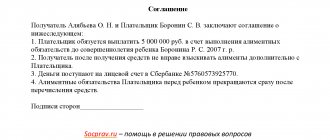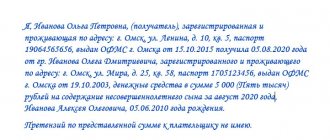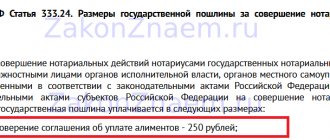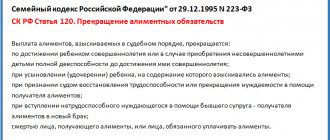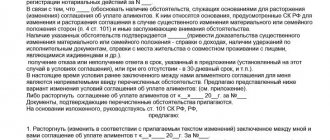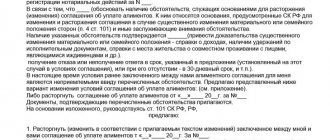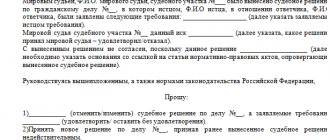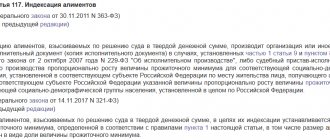Increasingly, parents are entering into an agreement to pay child support. This is the most civilized way to independently agree and consolidate the agreements of those who are obliged to help financially. An agreement to pay child support can be concluded by any person, not only parents.
Below you can agree. Choose a convenient method for calculating and receiving payments. Additional questions can be directed to the site's lawyer.
Payment of alimony by agreement is better than payment without execution of any documents. Voluntary payments can be terminated at any time, while an agreement on the payment of alimony has the force of an executive document. There will be no need to go to court, obtain a writ of execution, etc. The agreement itself can be sent to the bailiff service, which allows it to be enforced. But for this it is important to comply with the form of the agreement.
Here you will learn:
|
Concept of alimony agreement
A child support agreement is a contract between the party obligated to pay child support and the party entitled to receive it. This agreement contains information about the amount, timing and procedure for obtaining such content. The agreement must be concluded in writing. A written document is signed by the parties and certified by a notary.
| It is important! |
| Only an agreement on the payment of alimony certified by a notary will have legal force. |
If the parties agreed among themselves to pay alimony orally, drew up a receipt or agreement, but did not contact a notary, this is not an agreement to pay alimony. The law imposes certain requirements on the document.
An agreement on the payment of alimony can be concluded in cases where the alimony payer does not refuse financial assistance. And everyone is satisfied with the conditions regarding the amount and procedure for paying money. For example, the father of a child agrees to pay ¼ of his income monthly for his maintenance. But he does not want alimony to be collected by court order. In this case, the right decision would be to contact a notary and conclude an agreement.
You should not contact a notary if there are disagreements between the parties, they argue and conflict. Perhaps you should first contact a mediator or other person who can help people come to an agreement. It should also be taken into account that the notary will charge a fee for drawing up and certifying an agreement on the payment of alimony. Its size is quite reasonable, taking into account the saving of time and effort for going to court.
| Note! |
| Application for a court order for alimony Claim for alimony |
Is it necessary to notarize a voluntary agreement?
It is extremely important to draft a voluntary agreement correctly. Only if certain requirements are met will the document still acquire its legal force. The law requires that the agreement be drawn up in writing and certified by a notary. In this case, the agreement will have legal force, and it can be compared with a writ of execution.
How to write a statement of claim to the court for alimony?
Read about deprivation of paternity for non-payment of child support here.
What are the validity periods of a writ of execution for alimony, read the link:
If notarization is not obtained, the agreement is void. Thus, there are no consequences when drawing up and all prescribed aspects turn out to be optional.
When contacting a notary, you can ask for a sample or form in order to draw up an agreement for further payment of alimony.
Who has the right to enter into an agreement on the payment of alimony
Only persons who are bound by alimony relations by force of law have the right to enter into an agreement. Persons who are not obligated to pay alimony do not have the right to enter into such an agreement.
The Family Code of the Russian Federation provides a complete list of persons obligated to pay and receive alimony:
- parents must support their children, including disabled adults;
- adult children - their needy, disabled parents;
- the needy spouse receives maintenance from the other;
- other family members - in the absence of parents, children or spouses.
Accordingly, all these persons have the right to draw up an agreement that determines the amount, conditions and procedure for paying alimony.
Sample receipt for receipt of alimony by agreement
The presented sample receipt for receipt of alimony under an agreement to pay it can be used in any situations where alimony is paid in cash.
Receipt for receipt of alimonyg. __________ “__”___________ ____ g. I ________ (full name of the alimony recipient), received funds (alimony) in the amount of __________ (in numbers and words) from ________ (full name of the alimony payer) for _____ (indicate for which month of which year the alimony was received) in accordance with a notarized agreement on the payment of alimony from "__"___________ G. Recipient of alimony:______ (signature and transcript) |
statements:
Receipt for receipt of alimony
How to draw up and conclude an agreement on the payment of alimony
When all the issues have been discussed and settled by the parties, they can be fixed on paper by drawing up a draft agreement. You can complete this project yourself or entrust the registration to a notary. But in any case, the agreement must be notarized.
What the agreement should contain:
- Place of conclusion of the agreement. This could be a city, town or other populated area.
- Conclusion date. The date must contain the day, month and year. You can write everything down or just indicate numbers. October 15, 2021 or October fifteenth two thousand eighteen.
- Document name: Agreement on payment of alimony
- Personal data of the parties. Mandatory - last name, first name and patronymic in full, without abbreviations, as in the passport. It is better to indicate other information: passport details, date and place of birth, place of registration and place of residence.
- Details of the person for whose maintenance alimony will be paid. If this is a child, then his full name, date of birth, who is the payer and recipient of alimony are indicated.
- Amount of alimony as agreed. If this is a fixed amount, then it is indicated in numbers and in words, for example, 5,000 (five thousand rubles). If these are shares of income, then their size. For example, ½ or ¼, exactly like this with a slash.
- Terms of payment of alimony. It is better to indicate that alimony is paid until a certain date, for example, until the 15th of each month. You can also specify a specific date - the 25th of each month.
- Payment procedure. In cash Ivanova A.I., for which the latter draws up a receipt. By transferring funds to the account of Ivanova A.I. using the following bank details: … .
- Additional terms of agreement. If the parties have any special wishes.
- The procedure for signing, concluding and certifying an agreement by a notary.
- The procedure for indexing alimony by agreement. If so provided by the parties. (See more details here: Indexation of alimony)
- At the end, the signatures of the parties must be placed. The agreement must contain the certifying signature of the notary, certified by his seal.
Child support agreements may have nuances in cases where they concern children, spouses or other persons, so we will provide samples of various documents.
How to determine the amount of alimony
The parties entering into the agreement independently agree on the amount of upcoming payments, but this amount should not contradict the laws of the Family Code
The amount of alimony under the agreement cannot be less than what the recipient could demand in court and can be determined either in a fixed sum of money or in shares in relation to income. The fixed sum of money can be determined by the recipient and the payer, and the amount in shares is determined as follows:
- 1 child - 1/4 of all income;
- 2 children - 1/3 of all income;
- 3 or more children - 1/2 of income;
- 3 or more children from different marriages - at least 1/6 for each child.
For example, if the recipient has the right to claim alimony in the amount of 10,000 rubles per month through the court, then this amount must also be indicated in the agreement. If the terms of the contract are violated, either party can use the legal force of this notarial document. You can transfer the agreement to the bailiff service or file a claim in court. In both cases, the bailiffs will legally collect the amount specified in the agreement.
If, nevertheless, the parties decide that the payment will be in the form of a transfer of property, they must first calculate alimony (annual or for the entire period of payments), evaluate the transferred property, agree on these calculations among themselves, and only then formalize the transfer. If this is real estate, you can sign an agreement and register the property in the name of the recipient (for example, a child). Both documents will confirm the fulfillment of alimony obligations.
Penalty for alimony in case of conclusion of an agreement
A penalty for alimony is a type of fine that must be paid if payments are made in violation of the terms specified in the agreement. Article 115 of the Family Code states that a penalty can be collected for each day of delay. That is, if the agreement specified the date of transfer of funds as the 1st day of each month, then the penalty can be reported on the third day. Moreover, its size is determined by 0.5% of the amount of the due payment.
But in order to determine the procedure and conditions for collecting a penalty, a clause about this must be included in the contract. For example, if the agreement states that for a month of delay a penalty of 1% of the total amount per day will be charged, then when this fact occurs, the agreement can be handed over to the bailiffs, and they will have to impose this sanction in accordance with the agreement.
But in such situations, the reasons why you cannot count on paying a penalty are also specified in advance, for example:
- if the recipient keeps the agreement and does not provide it to the payer’s employer;
- in case of delay or absence of salary to the payer;
- if the recipient has an illness that does not allow him to earn money at a given time;
- force majeure (for example, natural conditions).
Force majeure is considered to be circumstances arising due to force majeure. That is, independent of a person and when a person can have little influence on the situation. Such circumstances include: earthquakes, floods, natural fires, mudflows, tsunamis, etc.
If the alimony payer was unable to work due to natural disasters, then a penalty cannot be collected from him for this period
Is it possible to pay alimony in foreign currency?
Even if the payer’s income is in foreign currency, then the agreement must include a clause on transferring the amount to rubles. For example, the salary of the alimony worker is $1,000, and the agreement stipulates a payment of $250. We introduce the following clause into the agreement: 25% of the salary is 250 dollars (14,250 rubles) at the exchange rate as of March 27, 2017. Also be sure to enable indexing. This is necessary in order to avoid disputes in the event of a sharp currency collapse.
The exception is cases when the payment of alimony is provided in kind. For example, according to the agreement, the payer must pay monthly for a children’s choreography and swimming club, buy consumables for the child’s artistic creativity (list of materials) and a set of medications (list). Here it becomes unimportant with what money and what currency these things were bought and paid for.
The subtlety of this issue is that the conditional transfer of foreign currency into rubles will help in the event of judicial settlement of disputes. Since the courts determine the amount of alimony only in Russian currency.
Sample agreement on child support in shares of earnings
Agreement on payment of child support in shares of earningsg. __________ “__”___________ ____ g. Citizen __________ (full name), hereinafter referred to as the “Payer”, on the one hand, and citizen __________ (full name), hereinafter referred to as the “Recipient”, on the other hand, have entered into this Agreement on the following: 1. In accordance with Articles 80, 81, 101 of the Family Code of the Russian Federation, the Payer pays the Recipient alimony for the maintenance of a minor _________ (full name of the child) “__”______ year of birth. 2. This agreement is valid until the child reaches the age of 18, the last payment is made in the month of reaching adulthood. 3. Under this agreement, alimony is paid by the Payer monthly in the form of ¼ of the payer’s earnings and (or) other income. 4. Payment of alimony is made until the _____ day of the month for the current month. 5. Payment of the above funds is carried out by delivering cash to the Recipient, against receipt. Receipts are kept by the Payer until the expiration of the agreement. 6. The payer undertakes:
7. The Recipient undertakes to inform the Payer about changes in bank account details and any other circumstances relevant to the timely fulfillment by the payer of his alimony obligations. 8. This Agreement comes into force from the moment of its notarization and terminates upon the occurrence of one of the following circumstances:
9. The amount of alimony may be reduced in the event of the birth (adoption) of children by the payer. 10. The parties have the right, by mutual agreement, to change this Agreement at any time or terminate it in accordance with the procedure established by law. 11. Unilateral refusal to fulfill this agreement is not permitted. 12. The costs of notarization of this agreement are borne by ________ (full name of the party). 13. This agreement is concluded in three copies having equal legal force, one for each party, one for keeping in the notary’s files. Alimony payer: ____________ Recipient of alimony: _____________ |
statements:
Agreement on payment of child support in shares of earnings
Possible options
According to Article 80 of the Family Code, parents must independently determine the form of providing financial support to their children together. Coercion is applied only when a man evades fulfilling his legal duties. The same rule states that the mother and father have the right to enter into a written agreement, which will set out the procedure for transferring finances.
However, this procedure is not mandatory. So how to pay child support correctly?
Former spouses who have chosen the voluntary method of fulfilling the obligation have several options:
- draw up a notarized “peace agreement”, recording on paper the frequency of transfers of funds and the exact amount of alimony;
- transfer money “from hand to hand”, each time making a receipt confirming the receipt of finance;
- the father can agree with the management at work about a monthly transfer of amounts to the child’s account (upon application).
The advantage of the first method is that the “alimony payer” is freed from the need to worry about paying the debt on time every time. He simply submits the document to the accounting department of the institution where he is employed. The force of a written agreement is equal to a court order and a writ of execution.
Based on the official paper, economists will independently deduct the necessary amounts from the salary (after making a tax deduction) and transfer them to the addressee, that is, the mother.
An undeniable advantage of the second method is the ability to negotiate if it is not possible to transfer or transfer funds in person within the prescribed period for any reason. Of course, this requires that the relationship between the former spouses be trusting. Payment “from hand to hand” does not imply the occurrence of debt as such.
Consequently, it will be impossible to collect a penalty for delay.
The method is appropriate in cases where the mother is ready to wait, if necessary, being confident that the father, after a certain period of time, will fulfill his child support obligations. In the conditions of the unstable Russian economy, citizens often suddenly find themselves unemployed, losing the opportunity to pay their offspring within the period established by law. By the way, the Republic of Belarus and Ukraine in this regard are similar to our state.
In such situations, ex-spouses often resort to transferring money using receipts.
Expert opinion
Pankov Roman
There is one more subtlety. If the parent agreed to pay child support voluntarily, this type of income is not taken into account when assigning a subsidy to the mother to pay for utilities. Even a small amount can affect the result.
Having officially an extra 2-3 thousand rubles, a woman is often deprived of the opportunity to receive this benefit from the state. This is another reason why ex-spouses agree on child support without any documentation.
This is important to know: Spousal share of inheritance after the death of a spouse
Sample agreement on payment of child support in a fixed amount
Agreement on payment of child support in a fixed amountg. __________ “__”___________ ____ g. Citizen __________ (full name), hereinafter referred to as the “payer,” on the one hand, and citizen __________ (full name), hereinafter referred to as the “recipient,” on the other hand, have entered into this Agreement on the following: 1. In accordance with Articles 80, 83, 101 of the Family Code of the Russian Federation, the payer pays alimony to the recipient for the maintenance of minors: _________ (child’s full name) “__”______ year of birth; _________ (child’s full name) “__”______ year of birth; _________ (child’s full name) “__”______ year of birth. 2. According to this agreement, alimony is paid by the payer monthly in the amount of ____ rubles. for each child. 3 This agreement is valid for each child until he reaches the age of 18, the last payment is made in the month he reaches adulthood. 4. Payment of alimony is made before the _____ day of the month for the current month by transfer to the recipient’s bank account using the following details: ___________. All costs associated with the transfer of funds are borne by the payer. 5. The payer undertakes:
6. The recipient of alimony undertakes to inform the Payer about changes in bank account details and any other circumstances relevant to the timely fulfillment by the payer of his alimony obligations. 7. This Agreement comes into force from the moment of its notarization. 8. The parties have the right, by mutual agreement, to change this Agreement at any time or terminate its validity in the manner prescribed by law. 9. Unilateral refusal to fulfill this agreement is not permitted. 10. The costs of notarization of this agreement are borne by ______________ (full name of the party). 11. This agreement is concluded in three copies having equal legal force, one for each party, one for keeping in the notary’s files. Child support payer: _________ Recipient of alimony: __________ |
statements:
Agreement on payment of child support in a fixed amount
How to choose a notary and whether certification can be refused
You have the right to choose a notary at your discretion, both public and private. If a document contradicts the law or contains errors or typos, you may be denied certification.
You can correct the shortcomings and contact the notary’s office again, or if you disagree, demand a written refusal and appeal it in court. Sometimes it is easier to contact another notary.
What is the cost of notarization
According to paragraphs. 9 clause 1 art. 333.24 of the Tax Code of the Russian Federation, the fee for notarization of a document will be 250 rubles. This is a required minimum expense. This price does not include consultation and document preparation by a notary.
The service for preparing an agreement is paid and is not obligatory for the parties. Its maximum size is established annually by the notary chamber for each region of the Russian Federation. You can find out the cost in your district on the website of the Federal Notary Chamber.
Since the law does not indicate which of the parties should bear the costs of paying for certification of the document, they decide this issue among themselves independently.
Important! If the agreement of the parties provides for the transfer of property to pay alimony, the cost of notary services will be higher.
What documents will be required
To have an agreement certified by a notary you will need:
- Passports of the parties.
- A draft document or its draft.
- Children's birth certificates/passports for children aged 14 to 18 years.
- Marriage/divorce certificates.
- Certificate of income of the payer.
- Documents for property (when transferring property to pay alimony).
Sample agreement on payment of alimony for a spouse
Agreement on payment of alimony for spousal supportg. __________ “__”___________ ____ g. Citizen __________ (full name), hereinafter referred to as the “payer,” on the one hand, and citizen __________ (full name), hereinafter referred to as the “recipient,” on the other hand, have entered into this Agreement on the following: 1. In accordance with Articles 89-92, 101 of the Family Code of the Russian Federation, the payer provides the recipient with maintenance for a period of __________ (indicate the specific period for providing maintenance or for life). 2. Starting from “__”___________, the payer pays the recipient monthly alimony in the amount of _____ rubles, which corresponds to 1 subsistence minimum established for the working population as a whole in the Russian Federation. The amount of money paid is subject to indexation in proportion to the change in the specified subsistence level. 3. Payment of alimony is made until the _____ day of the month following the settlement month. 4. Payments of the above funds are made by crediting the payer to the recipient’s bank account using the following details: ________. The costs of transferring funds are borne by the alimony payer. 5. The payer undertakes:
6. The recipient undertakes to inform the payer about changes in bank account details and any other circumstances relevant to the timely fulfillment by the payer of his alimony obligations. 7. This Agreement comes into force from the moment of its notarization. The parties have the right, by mutual agreement, to change this Agreement at any time or terminate its validity in accordance with the procedure established by law. Unilateral refusal to fulfill this agreement is not permitted. 8. The costs of notarization of this agreement are borne by ________ (full name of the party). 9. This agreement is concluded in three copies having equal legal force, one for each party, one for keeping in the notary’s files. Alimony payer: ___________ Recipient of alimony: ____________ |
statements:
Agreement on payment of alimony for spousal support
Payment procedure and amounts
The procedure for paying alimony is determined by the parties voluntarily. The most commonly used standard option is monthly payments, the amount of which must also be properly determined.
The legislator provides the following methods for calculating alimony:
- as a percentage of the payer’s income.
- in a fixed amount.
- through the transfer of certain property or a one-time payment of a large sum of money.
Fractional size
Calculation of alimony in a shared ratio is used, as a rule, when the payer has a regular income. Its size will be standard: for one child - a quarter, for two - a third, and for three or more - half of the income.
Important! These are the minimum amounts of alimony; the parties can agree on a larger amount, since the law does not limit the upper limit of alimony.
Fixed amount
Alimony in a fixed amount is also calculated according to established rules and depends on the cost of living for the child in the region of his residence.
If such an indicator is not established in a specific region, then the federal one is used for calculation. The size is not always equal to one such value, but can be any value.
The minimum wage can also be used as a starting value for calculating alimony.
One-time payment
The parties may provide for the possibility of transferring certain property as alimony. It must be valuable property, such as a home for the child and the parent who remains with him.
A one-time payment of a large amount of funds is also allowed, the amount of which at the time of transfer cannot be less than the total amount of alimony for the entire period of payments that would be due to the child by law.
The parties may provide for a mixed procedure for calculating alimony. For example, the payer transfers an apartment and at the same time continues payments in the established amount or transfers part of the alimony in a fixed amount and the other as a percentage.
Sample agreement on child support for a parent
Agreement on payment of child support for a parentg. __________ “__”___________ ____ g. Citizen __________ (full name), hereinafter referred to as “payer 1”, citizen __________ (full name), hereinafter referred to as “payer 2”, and together referred to as “payers” on the one hand, and citizen __________ (full name), hereinafter referred to as “recipient”, on the other hand the other parties have entered into this Agreement as follows: 1. In accordance with Articles 87, 101 of the Family Code of the Russian Federation, payers, being children of the recipient, provide maintenance to the recipient in connection with his disability and need for financial assistance. 2. Under this agreement, alimony is paid by payers monthly by crediting to the recipient’s bank account using the following details __________. 3. Payer 1 pays alimony in the amount of _____ rubles. before the ___ day of each month, for the current month. The costs of transferring his funds are borne by this payer. 4. Payer 2 pays alimony in the amount of _____ rubles. before the ___ day of each month, for the current month. The costs of transferring his funds are borne by this payer. 5. Payers undertake to: pay alimony on time; notify the recipient of all changes affecting the possibility of reducing the amount of alimony. 6. The recipient of alimony undertakes to inform payers about changes in bank account details and any other circumstances relevant to the timely fulfillment by payers of their alimony obligations. 7. This agreement comes into force from the moment of its notarization. 8. The parties have the right, by mutual agreement, to change this Agreement at any time or terminate its validity in the manner prescribed by law. 9. Unilateral refusal to fulfill this agreement is not permitted. 10. The costs of notarization of this agreement are borne by ______________ (full name of the party). 11. This agreement is concluded in three copies having equal legal force, one for each party, one for keeping in the notary’s files. Alimony payer: _______________ Recipient of alimony: ________________ |
statements:
Agreement on payment of child support for a parent
Invalid
There are times when an agreement turns out to be invalid. The reasons for this may be the following:
- if the requirements established by law are violated;
- if the agreement is drawn up without taking into account the interests of the child;
- if there is no mutual consent and the document is drawn up using force or intimidation.
In this case, the law establishes a period when it is possible to file a claim to declare the agreement invalid. It is 1 year.
Change and termination of alimony agreement
The agreement can be changed by mutual consent. You can’t just start paying child support in a smaller amount or at a different time. You cannot come up with any additional conditions for the payment or receipt of alimony that are not provided for in the notarized agreement. In addition, one cannot refuse to fulfill agreements, even by simply agreeing among themselves without concluding an additional agreement.
All changes to the agreement must be in writing and certified by a notary. It is from the moment of notarization that all changes come into legal force and their execution can be demanded, including by force. The agreement is also terminated through a notary.
If the parties were unable to reach an agreement on changing or terminating the agreement when it significantly violates the rights of one of the parties (for example, the financial situation of the alimony payer has changed, his income has decreased significantly), the dispute can be resolved in court. An interested party may apply to the court to amend or terminate the agreement, as well as to declare it invalid (Article 101-103 of the Family Code of the Russian Federation).
statements:
statement of claim to change the agreement on payment of alimony
statement of claim for termination of an agreement to pay alimony
How to make changes
If the parties to a previously concluded agreement need to make changes, they have the right to do so at any time. The procedure for making changes is the same as when concluding it - in writing with certification from a notary.
Most often, changes are made when the financial/family situation of the payer changes. So, for example, if during the period of the agreement more children were born/he became incapacitated/lost his job, etc., the parties have the right to agree on new conditions and notarize them.
Changing the document unilaterally is not allowed. If one of the parties does not agree with the proposed changes, the issue will have to be resolved in court. In this case, a statement of claim is filed in the district (city) court at the place of residence of the defendant or in the court that the parties have determined in the document.
However, before this, the initiator of making adjustments should send a written proposal to the other party to voluntarily make changes to the document. Since this is necessary for this category of cases (change/termination of agreement). Compliance with the pre-trial dispute resolution procedure is mandatory.
Execution of the agreement
An agreement on the payment of alimony, certified by a notary, is itself a writ of execution. This means that if you refuse to pay alimony, you can immediately contact the bailiff service. There is no need to additionally go to court for a court order to collect alimony or a decision to pay alimony.
The applicant fills out an application addressed to the bailiff. To which is attached a genuine notarized agreement on the payment of alimony.
| Note! |
| Application for initiation of enforcement proceedings |
The bailiff will initiate enforcement proceedings, determine the debt and take measures to collect alimony, including periodic payments by deduction from wages. The bailiff can collect the accumulated debt, but not more than 3 years. Therefore, it is better not to delay in presenting the agreement for enforcement.
This execution procedure makes it preferable to an oral agreement on the payment of alimony. After all, an agreement that is not properly executed will make it impossible to present any demands later.
General information
Alimony in Russia is paid in accordance with the norms of family law (Chapter 17 of the RF IC). This regulatory act regulates the methods of collecting payments, deadlines, grounds for termination of payments, and much more.
We invite you to familiarize yourself with the Agreement for the exchange of land for a land plot
A parent may provide financial assistance to a minor child voluntarily. In this case, it is necessary to draw up an agreement, with the help of which it will subsequently be possible to prove the fulfillment of this obligation. If the payer refuses to transfer alimony, the child's guardian goes to court.
Even if there is a court order, payment may be voluntary. If even then the parent refuses to fulfill his duties, collection is carried out forcibly through bailiffs. Then other means are used - seizure of property and bank accounts, search for the debtor, ban on leaving the country and much more.
This is important to know: Entering into inheritance by law and will: pitfalls

